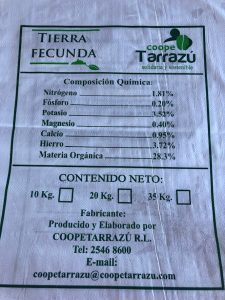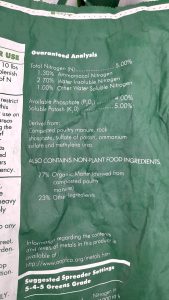Fertilizer analysis
Amber Anderson and Arturo Flores
- Identify components of fertilizers
- Calculate quantity of a given fertilizer needed to meet nutrient needs
Guaranteed analysis
Commercial fertilizers sold in the US are required to share amount of nutrients contained in the product on the label. The standard way to share this information is called a guaranteed analysis, like 10-10-10. The first number refers to percent nitrogen by weight, the second phosphorus as P2O5, and the third refers to potassium as K2O. Note that this exact form of nutrient isn’t required to be in the bag, but an equivalent amount of P or K is required, so this is simply a standardized way to express quantity of a nutrient.
Other material in a bag
Note that the percentages of N, P2O5, and K2O don’t add up to 100% of the bag contents. Other materials that wouldn’t be counted in this guaranteed analysis number could be nutrient carriers that contain the nutrient, conditioners that improve some property of the material, or inert materials that may make a small quantity of nutrient easier to spread uniformly over a large area.
Carriers
Not all molecules in a compound are the target nutrient for fertility. In urea, a nitrogen fertilizer, nitrogen is contained, but not all of the molecule.
Other nutrients
Nutrients besides nitrogen, phosphorus, or potassium are still needed by plants, and may be included in a fertilizer mix. Those contents would not be reflected in the guaranteed analysis of the material
Conditioners
Some fertilizers have less than ideal handling or storage properties-so materials to prevent caking, adjust the pH, or otherwise create more favorable conditions for storage or handling may be included.
See this container of fish emulsion fertilizer:
Note the three numbers in the lower part of the label, the guaranteed analysis of this product: 2-3-1
Example
Fertilizer bag from a Costa Rican Coffee Cooperative:
 This Costa Rican fertilizer bag has percentages of each nutrient contained instead of the guaranteed analysis required on US fertilizer bags. Note that this label shares nitrogen, phosphorus, potassium, magnesium, calcium, iron, and organic material percentages.
This Costa Rican fertilizer bag has percentages of each nutrient contained instead of the guaranteed analysis required on US fertilizer bags. Note that this label shares nitrogen, phosphorus, potassium, magnesium, calcium, iron, and organic material percentages.
Organic-derived fertilizer used for turfgrass management:
-

Organic fertilizer bag for turfgrass. Photo Credit: Arturo Flores. Compared to commercial syntethic formulas, this product contains significantly lower levels of each nutrient. The reason is they are meant for soil-nutrient maintenance and not for building the main nutrient pool.
- Also important to note, here, Nitrogen is divided into three categories:
- Ammoniacal Nitrogen: represents instant availability for root absorption.
- Water Insoluble Nitrogen: this is some type of slow-release fertilizer, which means it requires a different process to break down and takes longer to be readily available, reducing leaching potential and providing long-term nutrition.
- Other Water-Soluble Nitrogen: also instant available nitrogen but in a different form than ammoniacal nitrogen.
- Guaranteed analysis on fertilizer bags indicates percentage of N-P2O5-K2O contained
- Other materials, like conditioners, carriers, or micronutrients may also be found

